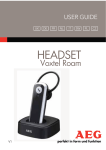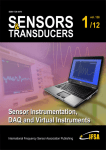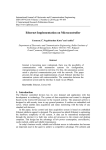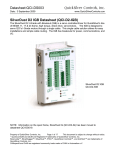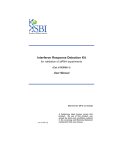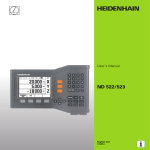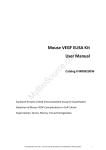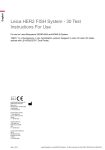Download Luc-Screen System® Protocol (PN T9019D)
Transcript
Applied Biosystems 35 Wiggins Avenue Bedford, MA 01730 (800) 542-2369 or (781) 271-0045, Press 2 Luc-Screen® System Extended-Glow Bioluminescent Reporter Gene Assay System for Detection of Firefly Luciferase P/N T1033, T1034, T1035 Contents PREFACE I. INTRODUCTION II. SYSTEM COMPONENTS III. LUCIFERASE DETECTION PROTOCOL IV. PROTOCOL NOTES V. APPENDICES A. Preparation of Controls B. Use of Luminometers C. Safety VI. REFERENCES Page 1 2 2 3 3 4 4 4 5 9 Part Number T9019 Revision D Revision Date: October 2008 For Research Use Only. Not for use in diagnostic procedures. Information in this document is subject to change without notice. APPLIED BIOSYSTEMS DISCLAIMS ALL WARRANTIES WITH RESPECT TO THIS DOCUMENT, EXPRESSED OR IMPLIED, INCLUDING BUT NOT LIMITED TO THOSE OF MERCHANTABILITY OR FITNESS FOR A PARTICULAR PURPOSE. TO THE FULLEST EXTENT ALLOWED BY LAW, IN NO EVENT SHALL APPLIED BIOSYSTEMS BE LIABLE, WHETHER IN CONTRACT, TORT, WARRANTY, OR UNDER ANY STATUTE OR ON ANY OTHER BASIS FOR SPECIAL, INCIDENTAL, INDIRECT, PUNITIVE, MULTIPLE OR CONSEQUENTIAL DAMAGES IN CONNECTION WITH OR ARISING FROM THIS DOCUMENT, INCLUDING BUT NOT LIMITED TO THE USE THEREOF, WHETHER OR NOT FORESEEABLE AND WHETHER OR NOT APPLIED BIOSYSTEMS IS ADVISED OF THE POSSIBILITY OF SUCH DAMAGES. Literature Citation: When describing a procedure for publication using this product, please refer to it as the Luc-Screen® System. Trademarks: Applied Biosystems, AB (Design), Luc-Screen and Tropix are registered trademarks of Applied Biosystems or its subsidiaries in the US and certain other countries. All other trademarks are the sole property of their respective owners. © Copyright 2008 Applied Biosystems. All Rights Reserved. PREFACE Safety Information Note: For general safety information, see this Preface and Appendix C, “Safety” on page 5. When a hazard symbol and hazard type appear by a chemical name or instrument hazard, see the “Safety” Appendix for the complete alert on the chemical or instrument. Safety Alert Words Four safety alert words appear in Applied Biosystems user documentation at point in the document where you need to be aware of relevant hazards. Each alert word—IMPORTANT, CAUTION, WARNING, DANGER—implies a particular level of observation or action, as defined below: IMPORTANT! – Indicates information that is necessary for proper instrument operation, accurate chemistry kit use, or safe use of a chemical. CAUTION! – Indicates a potentially hazardous situation that, if not avoided, may result in minor or moderate injury. It may also be used to alert against unsafe practices. WARNING! – Indicates a potentially hazardous situation that, if not avoided, could result in death or serious injury. DANGER! – Indicates an imminently hazardous situation that, if not avoided, will result in death or serious injury. This signal word is to be limited to the most extreme situations. MSDSs The MSDSs for any chemicals supplied by Applied Biosystems are available to you free 24 hours a day. For instructions on obtaining MSDSs, see Obtaining MSDSs on page 6. IMPORTANT! For the MSDSs of chemicals not distributed by Applied Biosystems contact the chemical manufacturer. How to Obtain Support For the latest services and support information for all locations, go to: www.appliedbiosystems.com At the Applied Biosystems web site, you can: • Access worldwide telephone and fax numbers to contact Applied Biosystems Technical Support and Sales facilities. • Search through frequently asked questions (FAQs). • Submit a question directly to Technical Support. • Order Applied Biosystems user documents, MSDSs, certificates of analysis, and other related documents. • Download PDF documents. • Obtain information about customer training. • Download software updates and patches. 1 I. INTRODUCTION Firefly luciferase is widely used as a reporter gene for studying gene regulation, gene function and for high throughput compound screening with gene expression assay. Luciferase is a very sensitive genetic reporter due to the lack of any endogenous activity in mammalian cells or tissues (1,2). Tropix® Luc-Screen® luciferase system is designed to provide a convenient and easy-to-use firefly luciferase detection assay, performed directly in microplate cell cultures in the presence of cell culture medium, particularly for use with high throughput screening applications. Luc-Screen® conveniently couples in-well cell lysis in the presence of culture medium with a high sensitivity assay that exhibits extended-glow light emission kinetics. Light signal can be measured between 10 minutes and several hours after adding assay reagents. Luc-Screen® system is designed for maximum assay flexibility in a high-throughput format and can be used in luminometers without automatic injectors. The system provides glow light emission kinetics, with a half-life of 4-5 hours, providing flexibility in the time between reagent addition and measurement. Detection of as little as 30-50 fg of luciferase is achieved in the presence of culture medium. The assay has a broad dynamic detection range of 50 fg to 100 ng of purified enzyme, greater than six orders of magnitude. Two reagents are added to cells in culture medium (with or without phenol red) in microplate wells. Although the presence of phenol red causes some decrease in signal intensity, assay sensitivity is not affected. If desired, culture medium can be removed and replaced with PBS containing Ca++ and Mg++. Cell lysis occurs during an initial 10 minute incubation; within this time, light signal reaches plateau. The light signal is then measured in a microplate luminometer. Solid white or white side/clear bottom tissue-culture microplates (not supplied) should be used. Applications The Luc-Screen® reporter gene assay system is ideal for high throughput firefly luciferase reporter assays in transiently and stably-transfected mammalian cells for gene expression assays (3,4), compound screening (5), as a read-out for cAMP induction in signaling pathways (6,7) and large-scale promoter function assays (8), as well as in insect cell lines (4). In addition, it has also been used as a read-out for viral replication (5) and a viral-mediated membrane fusion assay (9). II. SYSTEM COMPONENTS Shelf life for all Luc-Screen® kit components is 1 yr when stored as indicated. Microplate assays Buffer 1 Buffer 2 T1035 200 2 x 5 mL 2 x 5 mL T1033 1000 2 x 25 mL 2 x 25 mL T1034 10,000 2 x 250 mL 2 x 250 mL 1. Buffer 1: Contains buffered luciferase reaction and cell lysis reagents. Store at -20°C. Buffer can be refrozen or stored at 4°C for one week. 2. Buffer 2: Contains luciferin substrate. Store at -20°C. Buffer can be refrozen or stored at 4°C for one week.. 2 III. LUCIFERASE DETECTION PROTOCOL Please read the entire Protocol and Notes sections before proceeding. All assays should be performed in duplicate or triplicate. See Appendix A for preparation of positive and negative controls. For the following hazards, see the complete safety alert descriptions in Appendix C “Safety” on page 5: WARNING! CHEMICAL HAZARDS. Buffer 1, Buffer 2. 1. Allow Buffers 1 and 2 to warm to room temperature (5 mL of Buffer 1 and 5 mL of Buffer 2 are required for one entire 96-well microplate). 2. Add Buffer 1 (50 μL/well) to cells in 100 μL of culture medium with or without phenol red (see Notes 1-3). 3. Add Buffer 2 (50 μL/well). Timing between addition of Buffer 1 and Buffer 2 is not critical. 4. Incubate for 10 min at room temperature (see Note 4). 5. Place microplate in a luminometer and measure for 0.1-1 sec/well. Light signal should decay with a half-life of 4-5 hr. IV. PROTOCOL NOTES 1. The use of white, tissue culture-treated microplates is recommended for optimal assay sensitivity. Clear-bottom white plates can be used to allow microscopic examination of cultures. White backing sheets may be applied to the plate bottom prior to signal measurement, if desired. The absolute light signal intensities will be higher (approximately two-fold), since the white backing reflects light toward the PMT detector, but relative signal levels should be unaffected. Black plates are not recommended, since they will cause reduced light yield due to absorbance of the luminescent signal. 2. A 2-4-fold decrease in signal intensity is typically observed in culture medium containing phenol red. 3. If desired, PBS containing 1 mM Mg++ and 1 mM Ca++ can be substituted for culture medium prior to assay. 4. For steady light emission, the temperature during assay and measurement should be maintained at 23-27°C. 3 V. APPENDICES A. Preparation of Controls Positive Control Prepare stock enzyme by reconstituting lyophilized luciferase (Sigma L-9506) to 1 mg/mL in 0.1 M sodium phosphate pH 7.0, 0.1% BSA. Store aliquots of stock enzyme at -80°C and use without repeated freeze/thaw. Generate a standard curve by serially diluting the stock enzyme in 100 μL of culture medium or buffer (PBS containing 1mM Ca++ and 1mM Mg++) used for experimental samples. For the high end of the dilution curve, use 1-10 ng of enzyme. Purified enzyme provides a positive control for the assay reagents, as well as a means to determine the range of detection of the luminometer instrumentation, if desired. The purified enzyme standard curve is not intended (or accurate) for absolute quantitation of reporter enzyme concentrations, as the specific activity of the purified enzyme preparation and the reporter enzyme may differ significantly. Additional positive conrols can include use of luciferase constructs that provide constitutive expression of reporter enzyme as a positive control for cell transfection. Negative Control Assay an equivalent culture of mock-transfected cells to determine assay background. In experiments involving induction of reporter expression, uninduced cells should be assayed as a negative control for total assay background. B. Use of Luminometers We recommend using a single-mode luminometer or a multi-mode detection instrument set for luminescence measurement to measure light emission from 96- or 384-well microplates. The linear range of detection will vary according to cell type and on the reporter enzyme expression level. The number of cells used per well should be optimized to prevent a measurement signal that is outside the linear range of the luminometer. Extremely high light signals can saturate the detector (very unlikely for experimental samples), resulting in erroneous measurements. Refer to your luminometer user’s manual to determine the upper limit for your specific luminometer. Contact Applied Biosystems Technical Support group for additional questions. 4 C. Safety General chemical safety Chemical hazard warning WARNING! CHEMICAL HAZARD. Before handling any chemicals, refer to the Material Safety Data Sheet (MSDS) provided by the manufacturer, and observe all relevant precautions. WARNING! CHEMICAL HAZARD. All chemicals in the instrument, including liquid in the lines, are potentially hazardous. Always determine what chemicals have been used in the instrument before changing reagents or instrument components. Wear appropriate eyewear, protective clothing, and gloves when working on the instrument. WARNING! CHEMICAL HAZARD. Four-liter reagent and waste bottles can crack and leak. Each 4-liter bottle should be secured in a low-density polyethylene safety container with the cover fastened and the handles locked in the upright position. Wear appropriate eyewear, clothing, and gloves when handling reagent and waste bottles. WARNING! CHEMICAL STORAGE HAZARD. Never collect or store waste in a glass container because of the risk of breaking or shattering. Reagent and waste bottles can crack and leak. Each waste bottle should be secured in a low-density polyethylene safety container with the cover fastened and the handles locked in the upright position. Wear appropriate eyewear, clothing, and gloves when handling reagent and waste bottles. Chemical safety guidelines To minimize the hazards of chemicals: • Read and understand the Material Safety Data Sheets (MSDSs) provided by the chemical manufacturer before you store, handle, or work with any chemicals or hazardous materials. (See “About MSDSs” on page 6.) • Minimize contact with chemicals. Wear appropriate personal protective equipment when handling chemicals (for example, safety glasses, gloves, or protective clothing). For additional safety guidelines, consult the MSDS. • Minimize the inhalation of chemicals. Do not leave chemical containers open. Use only with adequate ventilation (for example, fume hood). For additional safety guidelines, consult the MSDS. • Check regularly for chemical leaks or spills. If a leak or spill occurs, follow the manufacturer’s cleanup procedures as recommended in the MSDS. • Comply with all local, state/provincial, or national laws and regulations related to chemical storage, handling, and disposal. 5 MSDSs About MSDSs Chemical manufacturers supply current Material Safety Data Sheets (MSDSs) with shipments of hazardous chemicals to new customers. They also provide MSDSs with the first shipment of a hazardous chemical to a customer after an MSDS has been updated. MSDSs provide the safety information you need to store, handle, transport, and dispose of the chemicals safely. Each time you receive a new MSDS packaged with a hazardous chemical, be sure to replace the appropriate MSDS in your files. Obtaining MSDSs The MSDS for any chemical supplied by Applied Biosystems is available to you free 24 hours a day. To obtain MSDSs: 1. Go to www.appliedbiosystems.com, click Support, then select MSDS. 2. In the Keyword Search field, enter the chemical name, product name, MSDS part number, or other information that appears in the MSDS of interest. Select the language of your choice, then click Search. 3. Find the document of interest, right-click the document title, then select any of the following: • Open – To view the document • Print Target – To print the document • Save Target As – To download a PDF version of the document to a destination that you choose Note: For the MSDSs of chemicals not distributed by Applied Biosystems, contact the chemical manufacturer. Chemical waste safety Chemical waste hazards CAUTION! HAZARDOUS WASTE. Refer to Material Safety Data Sheets and local regulations for handling and disposal. WARNING! CHEMICAL WASTE HAZARD. Wastes produced by Applied Biosystems instruments are potentially hazardous and can cause injury, illness, or death. 6 WARNING! CHEMICAL STORAGE HAZARD. Never collect or store waste in a glass container because of the risk of breaking or shattering. Reagent and waste bottles can crack and leak. Each waste bottle should be secured in a low-density polyethylene safety container with the cover fastened and the handles locked in the upright position. Wear appropriate eyewear, clothing, and gloves when handling reagent and waste bottles. Chemical waste safety guidelines To minimize the hazards of chemical waste: • Read and understand the Material Safety Data Sheets (MSDSs) provided by the manufacturers of the chemicals in the waste container before you store, handle, or dispose of chemical waste. • Provide primary and secondary waste containers. (A primary waste container holds the immediate waste. A secondary container contains spills or leaks from the primary container. Both containers must be compatible with the waste material and meet federal, state, and local requirements for container storage.) • Minimize contact with chemicals. Wear appropriate personal protective equipment when handling chemicals (for example, safety glasses, gloves, or protective clothing). For additional safety guidelines, consult the MSDS. • Minimize the inhalation of chemicals. Do not leave chemical containers open. Use only with adequate ventilation (for example, fume hood). For additional safety guidelines, consult the MSDS. • Handle chemical wastes in a fume hood. • After emptying a waste container, seal it with the cap provided. • Dispose of the contents of the waste tray and waste bottle in accordance with good laboratory practices and local, state/provincial, or national environmental and health regulations. Waste disposal If potentially hazardous waste is generated when you operate the instrument, you must: • Characterize (by analysis if necessary) the waste generated by the particular applications, reagents, and substrates used in your laboratory. • Ensure the health and safety of all personnel in your laboratory. • Ensure that the instrument waste is stored, transferred, transported, and disposed of according to all local, state/provincial, and/or national regulations. IMPORTANT! Radioactive or biohazardous materials may require special handling, and disposal limitations may apply. 7 Biological hazard safety General biohazard WARNING! BIOHAZARD. Biological samples such as tissues, body fluids, infectious agents, and blood of humans and other animals have the potential to transmit infectious diseases. Follow all applicable local, state/provincial, and/or national regulations. Wear appropriate protective equipment, which includes but is not limited to: protective eyewear, face shield, clothing/lab coat, and gloves. All work should be conducted in properly equipped facilities using the appropriate safety equipment (for example, physical containment devices). Individuals should be trained according to applicable regulatory and company/institution requirements before working with potentially infectious materials. Read and follow the applicable guidelines and/or regulatory requirements in the following: – U.S. Department of Health and Human Services guidelines published in Biosafety in Microbiological and Biomedical Laboratories (stock no. 017-040-00547-4; bmbl.od.nih.gov) – Occupational Safety and Health Standards, Bloodborne Pathogens (29 CFR§1910.1030; www.access.gpo.gov/nara/cfr/waisidx_01/29cfr1910a_01.html). – Your company’s/institution’s Biosafety Program protocols for working with/handling potentially infectious materials. IMPORTANT! Additional information about biohazard guidelines is available at: www.cdc.gov Chemical alerts For the definitions of the alert words IMPORTANT, CAUTION, WARNING, and DANGER, see “Safety alert words” on page 1. General alerts for all chemicals EXAMPLE: Avoid contact with (skin, eyes, and/or clothing). Read the MSDS, and follow the handling instructions. Wear appropriate protective eyewear, clothing, and gloves. Specific chemical alerts WARNING! CHEMICAL HAZARD. Buffer 1 may cause eye, skin, and respiratory tract irritation. Read the MSDS, and follow the handling instructions. Wear appropriate protective eyewear, clothing, and gloves. WARNING! CHEMICAL HAZARD. Buffer 2 may cause eye, skin, and respiratory tract irritation. Read the MSDS, and follow the handling instructions. Wear appropriate protective eyewear, clothing, and gloves. 8 VI. REFERENCES 1. Gould, SJ and S Subramani (1988). Firefly luciferase as a tool in molecular and cell biology. Anal Biochem 175:5-13. 2. Brasier, AR, JE Tate and JF Habener (1989). Optimized use of the firefly luciferase assay as a reporter gene in mammalian cell lines. BioTechniques 7:1116-1122. 3. Ahmed, CMI, KN Wills, BJ Sugarman, DE Johnson, M Ramachandra, TL Nagabhushan and JA Howe (2001). Selective expression of nonsecreted interferon by an adenoviral vector confers antiproliferative and antiviral properties and causes reduction of tumor growth in nude mice. J Interferon Cytokine Res 21:399-408. 4. Li, J and C-Y Wang (2008). TBL1-TBLR1 and catenin recruit each other to Wnt taget-gen promoter for transcirption activation and oncogenesis. Nature Cell Biol 10(2):160-169. 5. Wang, X, H Miyake, M Okamoto, M Saito, J-I Fujisawa, Y Tanaka, S Izumo and M Baba (2002). Inhibition of the Tax-dependent Human T-Lymphotropic Virus Type I replication in persistently infected cells by the fluoroquinolone derivative K-37. Mol Pharmacol 61(6):13591365. 6. Reinscheid, RK, Y-L Xu, N Okamura, J Zeng, S Chung, R Pai, Z Wang and O Civelli (2005). Pharmacological characgerization of human and murine neuropeptide S receptor variants. J Pharmacol Exp Therapeut 315(3):1338-1345. 7. Nagasaki, H, Z Wang, VR Jackson, S Lin, H-P Nothacker and O Civelli (2006). Differential expression of the thyrostimulin subunits, glycoprotein α2 and β5 in the rat pituitary. J Mol Endocrinol 37:39-50. 8. Coleman, SL, PR Buckland, B Hoogendoorn, C Guy, K Smith and MC O’Donovan (2002). Experimental analysis of the annotation of promoters in the public database. Human Mol Gen 11(16):1817-1821. 9. Baba, M, K Takashima, H Miyake, N Kanzaki, K Teshima, X Wang, M Shiraishi and Y Iizawa (2005). TAK-652 inhibits CCR5-mediated Human Immunodeficiency Virus type 1 infection in vitro and has favorable pharmacokinetics in humans. Antimicrob Agents Chemother 49(11):4584-4591. For complete, updated reference list (AB #120MI10), please see http://www.appliedbiosystems.com (Product & Service Literature). 9











